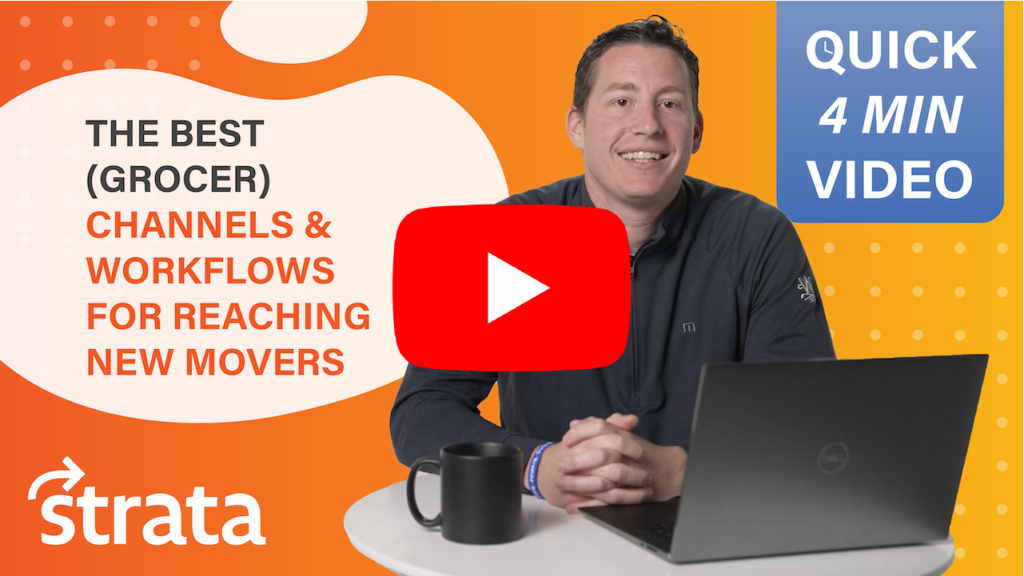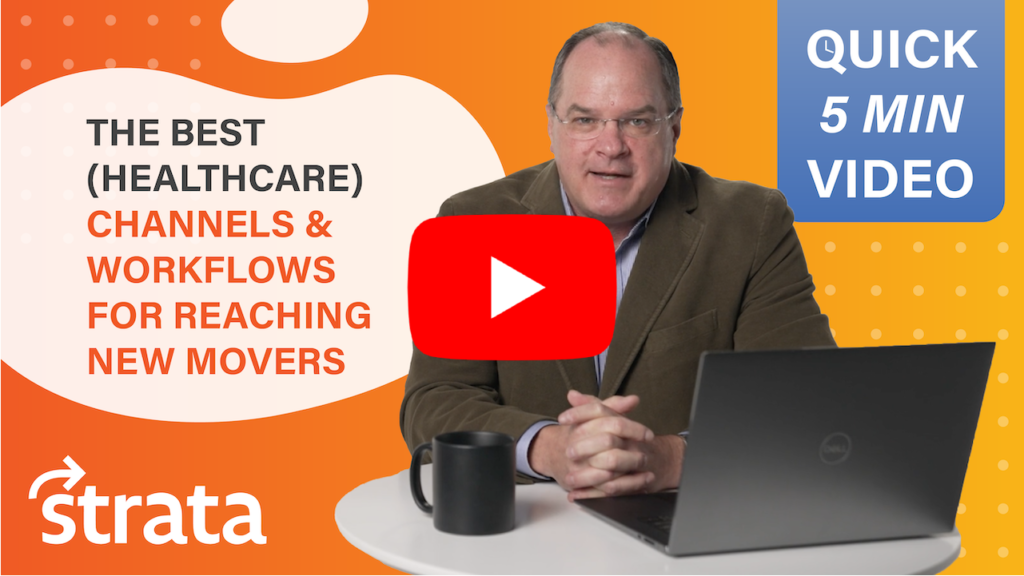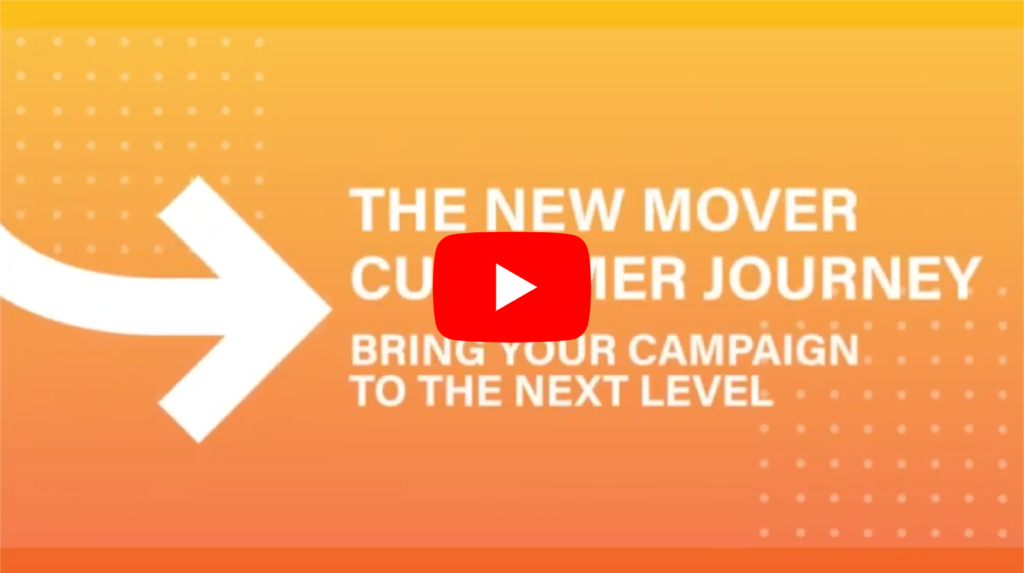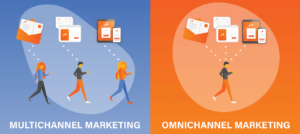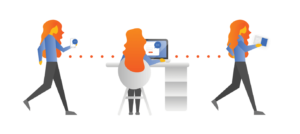A Strata YouTube Channel Original
In our last few blogs (and their corresponding YouTube videos) we’ve gone over the basics of new mover marketing, how to choose the right partner, and some steps to get started. Now, it’s time to take a deeper dive into how you can specifically utilize new mover marketing in the grocery industry and what channels and workflows work best.
A Quick Review of New Mover Marketing
To give you a brief refresher, new mover marketing is a specific, niche marketing tactic that’s designed to reach new residents in your area. It’s one of the most effective ways to bring in new customers that have just recently entered your specific target market. When it comes to new movers, they’re nobody’s customer, yet – so it’s an effective tactic to make a good first impression at the same time they’re looking for your product or service.
What do New Residents Really Want?
To answer the question, new residents are looking for “reliables”. These are goods and/or services that new movers can depend on daily, weekly, monthly, or even yearly. Since they’re new to the area, they’re usually unsure where to start. When it comes to grocery stores, sometimes there can be almost too many options for consumers to choose from. Because of this, you, as a grocery store, are in constant competition with other stores near you. That’s why it’s so important for your grocery store to be the first to reach out and make the consumer aware of your store – before competitors – and show them you’re close by. With immediate outreach, they’ll see you care, are convenient, and have quality goods.
The Best New Mover Channels for Grocers
We’ve deemed ourselves experts in new mover marketing all around – and we’re very practiced in some of the best channels and workflows for grocers (specifically) to reach new movers. One of the best channels you can take advantage of is direct mail. We know direct mail to be vital to the success of new mover campaigns, especially those of grocery stores. When mail is executed correctly, with personalization and attribution tactics, it can cut through all the digital noise and stand out in the mailbox. As we’ve mentioned in past blogs and videos, the average response rate for direct mail can be up to 50% more effective than those of email blasts, so it’s definitely worth your time and money!
Like we hinted at above, not all direct mail is created equal, so we suggest that those in the grocer industry send a “welcome handshake”. This is either a 6×9 or 6×10 postcard or bifold that allows your store to be introduced and represented in the best way possible. Again, the key to a good direct mail campaign is making sure it’s personable and actionable. With personalization and calls-to-action, you can welcome new movers to the neighborhood by first name and provide a personalized offer, which they can access by QR code or PURL. Another option? Provide a personalized coupon that they can redeem in-store, upon their first visit. If you want to go a step further in terms of personalization, include a map that shows the location of your store relative to their new residence. Generally, you want to make it as easy and enticing as possible for new movers to choose and visit your store.
What’s Next?
With this quick read, you now have a look into one of the top grocery industry channels to utilize for your next new mover campaign. But – it doesn’t stop there! We still have more suggestions when it comes to the best channels and workflows for grocery establishments like yours. Head over to our YouTube channel, where you’ll hear these suggestions from Connor, a member of Strata’s Strategic Sales Team. Or, if you’re ready to take these new mover marketing steps with Strata, contact us today.
A Strata YouTube Channel Original
In our last three blogs (and their corresponding YouTube videos) we’ve gone over the basics of new mover marketing. It’s important to remember that new mover marketing can differentiate between industries, so the best plan of action for specific business types may not be the same as others. In this blog and its corresponding YouTube video, we’re taking a deep dive into how you can specifically utilize new mover marketing in the healthcare sector – as well as what channels work best.
A Quick Refresher on New Mover Marketing
To give you a brief refresher, new mover marketing is a specific, niche marketing tactic that’s designed to reach new residents in your area. It’s one of the most effective ways to bring in new customers that have just recently entered your specific target market. When it comes to new movers, they’re nobody’s customer, yet – so it’s an effective tactic to make a good first impression at the same time they’re looking for your product or service.
What are New Residents Actually Looking For?
To answer the question, new residents are on the lookout for “reliables”, which are goods and services they can depend on daily, weekly, monthly, or even yearly. The healthcare industry is full of these “reliable” services – and these services are much different than those of grocery stores and restaurants. Customers will more likely choose any grocery store or restaurant to at least check out and maybe turn into their new “go-to” spot. If it ends up that they don’t like the spot – it’s really no big deal. They’ll move on and find another. With healthcare, most people don’t want to “try out” 4 or 5 doctors/healthcare services until they find one they like. In general, it’s a lot more work to fill out paperwork and questionnaires at healthcare offices, and most people only want to do that once.
Potential patients want to feel important and valued, so it’s key to be the first to reach out. When you reach out – first, the potential patient can get to know you and your system, while ensuring that you’ll be there in their times of need.
Best New Mover Healthcare Campaign Channels
Based on our years of expertise and data collection, we’ve compiled a list of what we think are the best channels to utilize when reaching out to new movers to hopefully turn them into patients. The first channel we recommend utilizing is direct mail. The average response rate for direct mail can be up to 50% more effective than that of an email blast, when done correctly. For a direct mail campaign to be done correctly, there must be some aspect of personalization, multiple response vehicles (such as QR codes and PURLs) and accurate data lists. The key to quality, effective direct mail is incorporating more than one touchpoint. If you’re able to send more than one direct mail piece, your potential patient will be consistently reminded of you and your business.
The next channel we recommend utilizing? Digital advertising. Targeted, focused ads can show potential patients that you’re close by and welcoming new patients. A benefit to using digital advertising? The level of precision. With digital ads, you can measure performance through impressions served and ad clicks. If you pair with the right new mover marketing partner for your business, you’ll be able to see how many and which customers converted due to your digital ads. This real-time data is vital to the success of your campaigns. It allows you to see what campaigns are working, which ones are not, and make the necessary adjustments on the fly rather than once the campaign is over.
What’s Next?
You now have some potential, optimal channels to utilize as a part of your next new mover campaign. But it doesn’t stop there! We still have more suggestions. Head over to our YouTube channel (by clicking the thumbnail below) to hear from Rob, a member of Strata’s Strategic Sales Team. He’ll fill you in on the rest of our channel recommendations. If your healthcare system is ready to take these new mover marketing steps with the team at Strata, contact us today.
How to Fight it & Flourish
As spooky season approaches and Halloween is around the corner, we’re thinking a lot about our biggest fears. But today we’re not talking about ghosts or goblins or even Michael Myers. We’re talking about one of the scariest things of all to any workplace…complacency.
“Complacency is man’s biggest weakness. It creeps up on us when we least expect it.” – Jay Mullings
Even if you think your company isn’t anywhere near complacency, there’s still always room to evaluate and grow. And, you may be surprised by what’s lurking behind the door of contentment. Complacency is not only bad for your company, but good for your competition, which we’d assume will give you a bit of a fright. If employees aren’t challenged to improve, things are the way they are because it’s the “way they’ve always been”, and the company isn’t growing, it’s definitely affecting your revenue. But don’t worry – it’s never too late to change. In this blog, we’ll take a look at the best ways to avoid company complacency and ensure you’re periodically updating and enhancing your culture, practices, and marketing.
Complacency’s Cause
Complacency can sneak up on any company without warning, shielding it from growth and stifling creativity and innovation. Why? Because if companies are seemingly doing “fine” and meeting their goals on paper, they feel no “need” or urgency to change. That’s where the biggest mistake is made, because companies should always be looking to evolve and thinking about their vision for the future. If not, ideas become stale, talent becomes bored, and eventually, the company comes to a jarring halt without any clue of how they got there.
When everything seems to be going well, it can be difficult to disrupt successes. And it may feel like the right decision to let processes and practices take their course rather than think about next steps and development, but often “the riskiest thing we can do is just maintain the status quo.” Without urgency and consistency for change, employee performance shifts and can even decline. Statistics show that only 30% of employees in America are actually engaged in their work, and only 13% of employees worldwide are engaged in their office environment. With such low numbers already, it’s so important to keep employees excited, energized, and motivated for what they’re doing and what’s to come.
Combatting Complacency
With complacency being a bigger, scarier possibility than you may have assumed, it’s important to keep it top of mind and to make sure you’re doing your best to combat it. Start with communication of your company’s mission, vision, and values. Make sure they’re clear, known, and maybe most importantly – accurate and true. Know who you are. If you do – your employees will too, and in turn they’ll feel more connected with and motivated by your workplace. Allow employees to see their contributions to the bigger mission, and their worth as an asset to the overarching vision.
After all, having a good (and growing) company culture is key to combatting complacency and ensuring workplace satisfaction. How do you improve your culture? Many ways, but the most effective tools are company newsletters, employee highlights, group meetings, and employee appreciation. Again – make your employees feel valued, and they’ll more likely provide value.
Additionally, make sure team members feel important and part of the greater whole. Encourage managers and team members to communicate within their individual teams, and make sure responsibilities are delegated and well distributed. Employees are more likely to become bored when they’re doing the same tasks over and over, so give them room to be creative and explore new opportunities. You never know who may have the next best idea.
Lastly, be prepared for whatever may come your company’s way, and never be too afraid to challenge the status quo. If we’ve learned anything these past two years, it’s that anything can happen, and that the saying “it won’t happen to us” is just not realistic. It’s important to listen to the ideas of your employees and always be prepared for what’s to come with an open communication structure. Make sure you have multiple decision makers, not just one, and that employees feel comfortable enough to make some decisions without “permission” from a leader. Training your employees to make decisions on their own will be a key factor in combatting complacency.
Refreshing Without Fear
Almost as important as your workplace and its people is your brand and marketing. Without change and evolution, your marketing can quickly become out-of-date right under your nose (causing your employees to lack company pride and your audience to lose interest). But how do you know when it’s the right time to update your brand and marketing?
A sure sign (these days) of lack luster marketing is an absence of social platforms. Some would even say if you’re not online, you might as well not exist. And although we think that sounds a little spooky, we’ll admit that it holds some truth. If you’re hard to find and not posting relevant content and imagery, target customers may be choosing your competitors (who are more accessible and approachable) over you.
Also important to your brand and its relevance is your website. In this day and age, it’s very easy to tell when a website has been left alone so long that it’s developing cob-webs. If you’re finding that your website traffic is down and your customers aren’t interacting with it, it’s time for an upgrade. But, before any big changes, compile data and make purposeful decisions. What is your audience looking for? What do they respond well too? How can you quickly and easily get them to have interest in your company and purchase goods?
Additionally, make sure you keep your advertising and customer communication – whether digital or physical – energized and creative. Combine direct and digital marketing to reach specific audiences and keep your brand top of mind. Don’t settle for just one medium that “seems to be working” if multiple channels of communication could bring you more success.
Lastly, avoid complacency by focusing on helping the customer rather than selling to them. While the overall goal of most companies is to generate sales, it’s essential you show your customers that you care about their pain points and needs. To see all of these tactics in action, check out our recent blog on how to create successful marketing campaigns.
Company complacency can sneak up on you like a ghost in the night and lead to missed opportunities, poor customer service, and disengaged employees. Stay aware of the possibility of contentment and make sure you’re always exploring, evolving, and rising above the rest. Change is inevitable, but complacency doesn’t have to be.
For more information on what we do at Strata and how we can help you fight complacency with one of our marketing solutions, contact us today.
All Your Questions Answered
There’s a lot of buzz around new mover marketing and the best ways to target potential new customers. And with all the attention and noise around it, the topic can get confusing and leave a lot of essential questions unanswered. Today, we’re going to answer all your questions about new mover marketing – and give you some insight into how to start a successful and smart new mover campaign.
Why should I target new movers in the first place?
Easy answer. With over 13% of Americans moving ever year, a ton of new movers are not only new to your area, but are looking for your business. They’re in a stage where they’re starting to develop what will become habitual shopping/buying habits and not looking for a reason to spend, but where to spend. Recent surveys show that 80% of new movers are willing to try new products since they’re in a new market and searching for new businesses and services. Also, how else are you going to replace those long-term, current clients that are moving out of your market area?
In what industries is new mover marketing effective?
Movers moving into a new house spend on average, $9,400 post-move, and that’s split into several different industries depending on the individual. When people move to new areas, they have several new (and already existing) needs that can only be met by several different industries. This means a new grocer, new healthcare provider, new dentist, new restaurants, a new gym… list goes on and on (and on).
Is it possible to segment who I target?
Yes, you can segment who you’re targeting based off age, demographic, and even by household income, to identify your ideal customer profile. The level of available segmentation depends on your new mover marketing partner and the technology that’s provided, but it can (and has been) done.
Can I have more than one touch point across several channels?
Absolutely! We recommend implementing multiple touch points that come from different angles. This means reaching your customers through several different channels, such as digital, direct mail, and email. All of these channels of communication, used together and correctly, are proven to show effective ROI.
How can I grow my new mover market through direct mail?
With around 61% of customers finding direct mail influential in making purchasing decisions, it’s important to make it one of the cornerstones of your new mover marketing campaigns. Direct mail can be personalized for the consumer, be authentic to your brand, and provides opportunity to be creative with how you market products and services to your consumers. Mailers that typically work best for new movers are dimensional mail, postcards, and bi-folds with incentive items.
How can I grow my new mover customer base with digital ads?
Hand in hand with direct mail, digital ads are excellent in getting your company’s name across your potential customer’s device. Creating display and banner advertisements is an effective way to send customers to your website or to a specific landing page. The power of digital marketing often speaks for itself, so it’s important to have elements of it involved in your new mover marketing campaign to reach all potential customers – not just some.
What kinds of responses should I expect throughout my campaign?
This all depends on the structure of your campaign and what kind of responses you’re aiming for. For instance, if you include a business reply card (BRC) within your direct mailer, your response rate will be based off how many potential customers fill them out and return them. Furthermore, the more aggressive your offer is for a direct response, the greater the response will be. Responses typically vary between industry and how many different touch points are built into your campaign. Response rates can also be determined by digital ads based off the number of consumers that interact with your landing page by clicks or submitted forms.
What’s the best way to track responses from my campaign?
When executing a new mover marketing campaign, make sure the program you’re using can easily track all progress, responses, and data that comes with the campaign. Find a partner with access to technology that allows you to see real time responses for your campaign and gain intelligence from those responses to make adjustments as it’s executed.
How do I effectively set up a new mover marketing campaign?
Picking the right partner is everything when it comes to successfully setting up a new mover marketing campaign. The right partner will provide the right data, the right technology, and a partnership with strong content creators who will represent your brand correctly. Work with a company that understands your markets and has several years of experience.
Looking for ways to incorporate a new mover marketing strategy into your next campaign? Here at Strata, we have years and years (and years) of experience under our belts. We’re here to assist you with all your new mover marketing questions and needs. Contact us today.
Bring Your Campaign to the Next Level
With over 40 million people moving every year, there’s a huge market for new customers moving into your target area. That said, many businesses have no idea where to start when it comes to targeting and reaching these new movers. Today, we’ll give you an overview of what new mover marketing is, the customer journey that a new mover takes, and the best channels and campaigns to reach them. Let’s dive in!
From Movers to Buyers
One of the most important things to realize about new movers is that they’re currently nobody’s loyal customer (yet). They’re a key group to target because they’re open to new businesses and products, and on average, develop 72 or more new business relationships within one year of moving. They’re also 5 times more loyal than your regular customer due to being new to the area. Once they find something they like, they’re willing to frequently buy it with ease. Making up 17% of the U.S. population, you can’t afford to miss these walking (and unpacking) opportunities. So, how are their (frequently loyal) buying habits formed? New movers are heavily influenced by timing. Whether you contact them before or after their move decides how they feel about your communication, and what they’ll do about it…
Pre-Move Buying Habits
Data shows that movers begin to stock up on home items right before they move. Products such as kitchen utensils, light fixtures, and everyday household tools are high on their list during this pre-move time.
Post-Move Buying Habits
After their move, new home buyers are likely to spend an average of $9,400, while renters spend around $4,700. Still, this number varies with age, area and demographic. Most of these buying decisions are made within the first few months of moving, which makes it the best time for your company to make contact, introduce yourself, and showcase your product.
A new mover’s first purchases will depend on their personal needs and priorities. For instance, a mover with medical needs may find a doctor immediately, while a mover with a large family may first find a new grocery store. Either way, they’ll have to find both eventually – and it’s likely they will within the first few months. Thankfully, new movers don’t need to be convinced to buy (they’re already more than ready), you’ll just need to convince them to make the right buy (from your company).
Staying in Touch
It’s not only important to get in touch with these potential loyal customers, but to stay in touch. After making a strong first impression, you’ll want to make more points of contact to ensure your company stays top of mind. It’s essential you have a good combination of marketing across several channels that are strategically picked and placed.
New Mover Marketing Tactics
There are several ways to reach these new movers, first, but since we’re experts – we’ll tell you the best ones. First is direct mail. Direct mail ideally arrives at the same time or a few days after new movers enter your neighborhood. Delivering direct mail that welcomes and attracts the new mover while introducing your business is a great way to begin an ongoing relationship. And the stats back this up – as 40% of consumers try new businesses after receiving direct mail. Direct mail is perfect as a first touch to new movers, as it’s personalized, meets them in their new home, and catches them at the right time.
A great way to ensure this direct mail delivers ROI is through BRCs (business reply cards) or eBRCs with incentives. A BRC is a vehicle that allows a prospective customer to provide information to send back to your business, and if incentivized, can return high response rates and bring you valuable customer data.
What’s the next best channel for reaching new movers? Digital advertising. Hand in hand with direct mail, digital ads can create brand awareness, link to your chosen landing page, and target specific online audiences. Digital advertisement placement and audience targeting are the top optimization tactics used by advertisers today.
Email is next – and combined with both direct mail and digital ads, email can be that final touch that brings your company new customers. Using either the BRC information or engagement with digital ads, emails are easy to obtain, making it almost effortless to add new customers to your automated or personalized promotional email campaigns.
The Visible Influence
New mover marketing allows marketers to influence movers’ buying decisions from the beginning of their move all the way until they walk into your doors. It’s about building immediate and vital relationships – because once a new mover buys from you and your shop, they’re 90% more likely to become a repeat customer.
If you want to dig even deeper, it’s smart to use a program that gives your business insight into your customers – such as live statistics and touchpoint behaviors. These meaningful insights will allow your shop to make enhancements on the fly and improve your campaigns, ultimately increasing ROI.
If you successfully target new movers, create convenient touchpoints that meet their needs, and maintain conversation as they have questions and reach out, the new mover will not only finish their journey as a customer, but as a loyal, repeat one. Looking for ways to incorporate a new mover marketing strategy into your next campaign? With years and years (and years) of experience under our belts, we’re new mover marketing experts. Contact us today.
An Intro to Omnichannel Marketing
What is Omnichannel Marketing Anyway?
In the past, before the great omnichannel marketing came about, many businesses solely relied on one-touch marketing campaigns that would die upon completion. They’d send out one piece of direct mail – one digital ad – one email – and expect a plethora of results. Whatever the trend of the moment was, that’s what they’d focus on, and only that.
Omnichannel marketing is “a cross-channel content strategy used to improve the customer experience and drive better relationships across all possible channels and touchpoints.” It takes all of the most relevant trends combined with multiple marketing touches to reach people how, when, and where they are, and provide them with the best customer experience, whether that experience be point-of-sale, digital, or physical. It meets customers where they are in the buyer journey with unified and steady messaging, instead of at a stop along the way.
At the end of the day, omnichannel marketing is all about driving better relationships – and targeting prospects and customers with the right messages, in the right places, at the right times.
Multichannel vs. Omnichannel
These sound very similar, and although they’re both great trends and important marketing tactics, they’re not one and the same. While omnichannel marketing, like we said above, is multiple marketing touches along the buyer’s journey, creating unified and steady messaging, multichannel marketing is interacting with potential customers on various platforms – but not necessarily messaging that’s tied together seamlessly and consistently. Multichannel marketing could mean you’re using print ads, retail locations, a website, promotional events, product packaging, and WOMM, but they may not all convey the same communication.
Here’s a trick to easily remember the difference:
- Multi means many (simply enabling each touch point), and casting the widest net to connect with the most customers
- Onmi means all (all touchpoints convey the same message to all customers), which focuses on building stronger relationships between consumers and brands
The Importance of Omnichannel
Omnichannel marketing can be great for many aspects of your business. Like we said, it can and will, if used correctly, attract the right people, at the right place, at the right time. In the digital age of 2021, it’s more important than ever to utilize technology to accurately find and target these recipients. Use omnichannel marketing to do the following for your company…
- Boost customer loyalty: Ensuring consistent messaging across all platforms, and going further to offer personalized experiences for each audience member, creates a better brand image and increases customer satisfaction
- Improve brand recall: Making sure your brand is represented in the same way across platforms and devices can produce better customer recollection
- Increase revenue: Content personalization, WOM marketing, and again, consistent messaging, can help retain and attract new customers
- Utilize purchasing patterns: 73% of shoppers use multiple channels during their purchasing journey, so capture your current audience and expand your content to reach a broader scope of your customers
Example of Omnichannel Marketing
To help you better understand how omnichannel marketing works, we’ve put together an example of omnichannel touchpoints along the customer journey, below:
Customer receiving text message about sales promo while in store -> Customer receiving an empty cart email at checkout -> Customer receiving retargeting digital and/or print ad
How to Get Started
Before jumping in and creating the marketing touchpoints of an omnichannel campaign, think about the customer first. Review all of your current touchpoints, and evaluate whether they provide a positive, consistent, and branded experience. Get to know your customer base even better by developing buyer personas and understanding their needs, wants, behaviors, demographics, preferences, goals, and more. Lastly, do a ton of tracking and research, hire the right guru, or choose the right partners to get going. Here at Strata we have data providers, digital advertising specialists, direct mail experts, and analytics and reporting professionals, all on staff and ready to help you – taking the guess work out of the entire process.
Still not sold? How about these statistics…brands experience a 287% higher purchase rate when using three or more channels, and companies with well-defined omnichannel customer experience strategies in place achieve a 91% higher year-over-year increase in customer retention rate on average.
Don’t wait to take advantage of what Omnichannel Campaign Marketing can do for your business. Click here to see how we can help.


